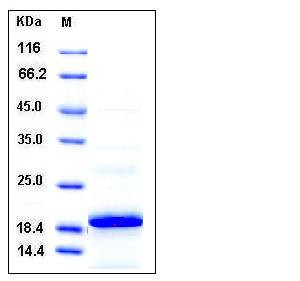Human 4E-BP1 / EIF4EBP1 Protein (His Tag)
4E-BP1,4EBP1,BP-1,PHAS-I
- 100ug (NPP3822) Please inquiry
| Catalog Number | P10022-H07E |
|---|---|
| Organism Species | Human |
| Host | E. coli |
| Synonyms | 4E-BP1,4EBP1,BP-1,PHAS-I |
| Molecular Weight | The secreted recombinant human 4EBP1 comprises 124 amino acids with a predicted molecular mass of 13.4 kDa. It migrates as an approximately 19 kDa band in SDS-PAGE under reducing conditions. |
| predicted N | Met |
| SDS-PAGE |  |
| Purity | > 90 % as determined by SDS-PAGE |
| Protein Construction | A DNA sequence encoding the human 4EBP1 (NP_004086.1) (Ser 2-Ile 118) with a N-terminal polyhistidine tag was expressed. |
| Bio-activity | |
| Research Area | Cancer |Signal transduction |Protein Trafficking |Vesicle Transport |Regulation |
| Formulation | Lyophilized from sterile 20mM Tris, 500mM NaCl, 10% glycerol 1. Normally 5 % - 8 % trehalose and mannitol are added as protectants before lyophilization. Specific concentrations are included in the hardcopy of COA. |
| Background | The translational suppressor eIF4E binding protein-1, 4E-BP1 functions as a key regulator in cellular growth, differentiation, apoptosis and survival. The Eif4ebp1 gene, encoding 4E-BP1, is a direct target of a transcription factor activating transcription factor-4 (ATF4), a master regulator of gene expression in stress responses. 4E-BP1 is characterized by its capacity to bind specifically to eIF4E and inhibit its interaction with eIF4G. Phosphorylation of 4E-BP1 regulates eIF4E availability, and therefore, cap-dependent translation, in cell stress. Binding of eIF4E to eIF4G is inhibited in a competitive manner by 4E-BP1. Phosphorylation of 4E-BP1 decreases the affinity of this protein for eIF4E, thus favouring the binding of eIF4G and enhancing translation. 4E-BP1 is important for beta-cell survival under endoplasmic reticulum (ER) stress. 4E-BP1 mediates the regulation of protein translation by hormones, growth factors and other stimuli that signal through the MAP kinase and mTORC1 pathways. Recently, 4E-BP1 was found to be a key factor, which converges several oncogenic signals, phosphorylates the molecules, and drives the downstream proliferative signals. Recent studies showed that high expression of phosphorylated 4E-BP-1 (p-4E-BP1) is associated with poor prognosis, tumor progression, or nodal metastasis in different human cancers. |
| Reference |
